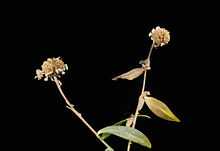Kalimeris indica
| Kalimeris indica | |
|---|---|
 | |
| Inflorescence of Kalimeris indica | |
| Scientific classification | |
| Kingdom: | Plantae |
| (unranked): | Angiosperms |
| (unranked): | Eudicots |
| (unranked): | Asterids |
| Order: | Asterales |
| Family: | Asteraceae |
| Genus: | Kalimeris |
| Species: | K. indica |
| Binomial name | |
| Kalimeris indica (L.) Sch.Bip. | |
| Synonyms[1] | |
| |
Kalimeris indica, also known as Indian aster or Indian Kalimeris, is a flowering herbaceous perennial plant of the family Asteraceae (Compositae). Kalimeris indica, like other species in the genus of Kalimeris, occurs mainly in eastern Asian countries of China, Korea and Japan,[2] but has been introduced to California[3] and Hawaii.[4]
Description

Kalimeris indica is commonly found along roads, on slopes of hills and ridges between rice fields. It can reproduce sexually through production of seeds and asexually through stolons.
Indian aster can grow to a height of 30–70 cm. Leaves are opposite and stems are typically upright. Blooming starts in late spring and will continue into October depending on the location. Disk florets are light yellow and ray florets are either light purple or white.
Uses


Indian aster has wide culinary uses in East Asia. Young leaves and stems are collected in early spring time and cooked with other food items such as dried beancurd. It is considered a delicacy because of its special flavor. It is particularly popular south of Yangtze River in China.
Roots and the whole plant of Indian aster is used in traditional Chinese medicine to treat a wide range of ailments.
References
| Wikimedia Commons has media related to Kalimeris indica. |
- ↑ "The Plant List: A Working List of all Plant Species".
- ↑ Hong-ya Gu and Peter C. Hoch (1997). "Systematics of Kalimeris (Asteraceae: Astereae)". Annals of the Missouri Botanical Garden 84 (4): 762–814. doi:10.2307/2992027. JSTOR 2992027.
- ↑ Corlette, Jan. "Global Biodiversity Information Facility". Retrieved 5 December 2012.
- ↑ "PLANTS Profile for Kalimeris indica | USDA PLANTS". Plants.usda.gov. Retrieved 2012-11-23.